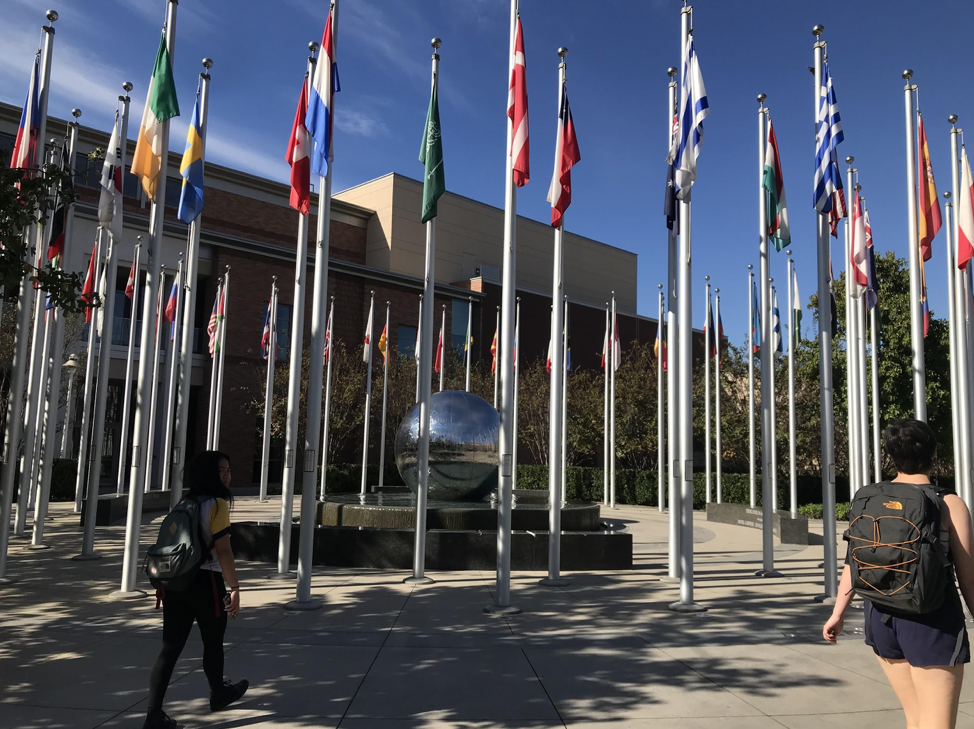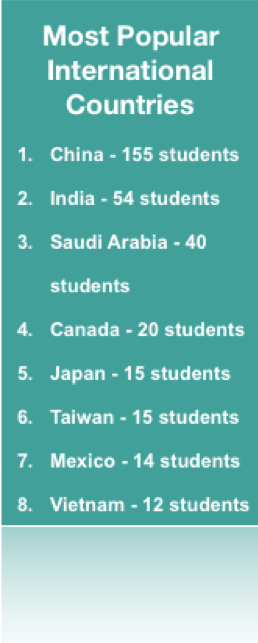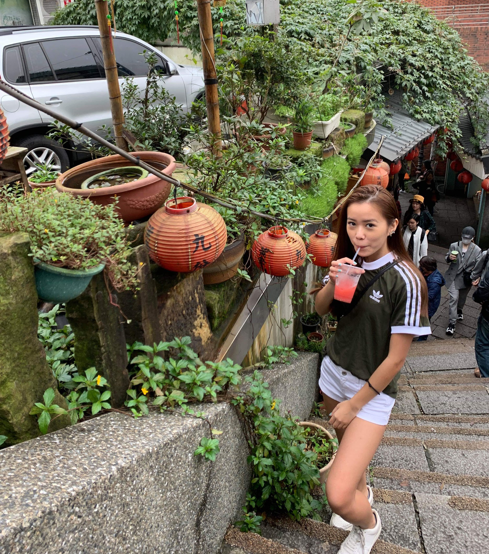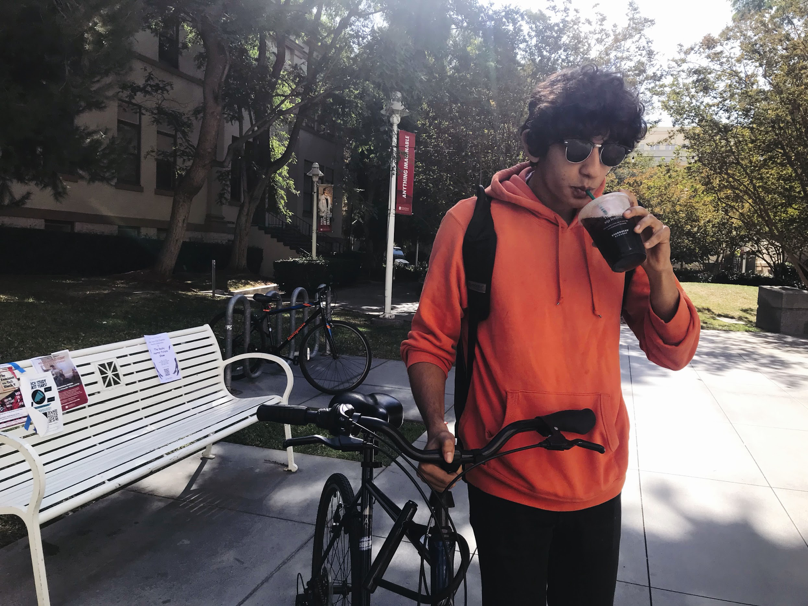
~~~~~~~~~~~~~~~~~~~~~~~~~~~~~~~
Santa Ana wind whistles through the flags of 64 countries displayed in the Argyros Global Citizens Plaza, a salute to Chapman University’s international community.
Although students come from 49 states and over 80 countries, the majority of Chapman’s student body are California residents with 4.8% of 2018’s freshman class being international and 32.9% out-of-state. This leads some to question whether Chapman’s demographics are as diverse as they appear to be.
“I know recently they’ve been trying to promote diversity at Chapman and trying to make it seem like a lot of international students go here, but the community is still very small,” said Tiffany Chen, a sophomore broadcast journalism and documentary and communications double major.

Home to 155 undergraduate and graduate students, China’s student numbers almost triples that of India’s. Graphic by Sydnee Valdez.
Chen is one out of the 15 undergraduate and graduate students from Taiwan. She attributes her decision to study in America to her experience as an elementary student in a British school in Hong Kong and a high school graduate of Taipei American School.
Back in Taiwan, she was considered the majority. After enrolling in Chapman, she found herself developing what she calls an “inferiority complex”.
“The biggest challenge is getting over that barrier of always having this subconscious voice in my head that says, ‘Oh I’m Asian, maybe they won’t like me,’” Chen said.
Senior business administration major Nina Nooteboom from Antioch, California shares a similar experience.
“In North Cal you talk about the struggles of getting out, and my first day here I heard two guys talking about how small their yachts were,” Nooteboom said. “I didn’t know what to talk about, so making friends wasn’t easy.”
But there are changes taking place.
In 2000, about half of the students that enrolled in the first-year class were from Southern California, according to Assistant Vice President of Admission Marcela Mejia-Martinez. This past year, that number reduced to only a quarter of the incoming students.
Chapman Admission uses a method called “Territory Management,” where each admission officer is given a territory and reviews all applications from that area, according to Mejia-Martinez who oversees the Hawaiian Islands.
This method allows admission officers who are familiar with the territory to contextualize where a student is coming from when they present students for admission.
“Becoming a national university has always been a big plan for the university prior to Daniele [Struppa] becoming president,” Mejia-Martinez said. “We’ve grown as an institution but expanded the access and the reach to really diversify that geography.”
The university heavily emphasizes global citizenship and geographic diversity through its Strategic Plan, general education requirements, and study abroad efforts.
Chapman Admission also hosts information sessions in different states and countries, some of the most recent being Panama and Brazil. Admission officers choose where they visit based on data from past applications, areas where students have shown an interest in Chapman, and relationships they have with high school counselors and community based organizations, according to Mejia-Martinez.
“We really want students to have a diverse experience while you’re here,” said Mejia-Martinez. “It’s a diversity of lived experiences, a diversity of thought of people who aren’t exactly like you.”
For some international students, studying in the U.S. means more opportunity for them to inform others of issues outside of their nation state.

“A lot of times, people won’t know what’s happening right now like the Hong Kong protests or the political tensions between China and Taiwan, and I’ll tell them about it,” said Chen.
Despite new opportunities, living in a new country also comes with its challenges.
Culture shock is one barrier that international and out-of-state students face. Besides the obvious climate and language differences, the variance of values and social norms are significant contributors to culture shock, according to the University of Washington Counseling Center.
“The people are different, the roads are different, the societal structure is different,” said sophomore screenwriting major Rohan Dias from India. “I don’t have manners. Manners will take you far here, and manners will get you scammed back home.”
While Dias cited his struggles with adapting to a school in Southern California, he admitted that geographic diversity is necessary in creating a more informed, well-rounded community.
“There’s a lot wrong with the way people think. If you have another perspective, it makes you realize that there’s more to see than what’s here,” Dias said. “There’s more perspective than your own little bubble of people.”

Broadening one’s perspective through geographic diversity is essential to a student’s education, according to Vice President for Student Affairs and Dean of Students Jerry Price.
“There’s value in going to a new place and learning how to adapt, but it is only of real value if you embrace that place you’re at,” Price said. “Every place has its own value and unique character to learn about.”
Chapman’s location was a major factor in students’ decision to enroll. For Chen, it was because of the way movies depicted Southern California with its beaches and Hollywood trademark. Nooteboom, on the other hand, traded North California for more surf opportunities and Old Towne Orange’s easy accessibility.
“Many students don’t come here just for us. They come here because they want to be a part of Southern California,” said Price.
Although the university does focus on recruiting students from international countries and outer states, it also focuses on globally educating all students.
In fact, Chapman requires students to complete a Global Citizens Cluster that includes language requirements and a citizenship, community, service inquiry. It is also requires six credits for its Global Studies Inquiry that may be satisfied with a semester spent studying abroad.
“The fact that we have this Global Citizens requirement for everybody tells you that it is our intent to embed that concept in every graduate,” said Price. “Even if you are from [here], we still want you to think globally. We want you to consider broad, global perspectives.”
Although many claim that having geographic diversity and a global perspective is a necessary part of the college experience, the international community is only a small portion of the Chapman demographic.
It is more expensive to recruit international and out-of-state students. They typically have to spend more to come, and they are more likely to have adjustment issues that increase the chances that they may not stay, said Price.
For example, students who have been a resident of California for at least a year qualify for Cal Grants that can lessen financial burdens.
Despite the financial barriers, some students found that moving away for college was the best option for them.
“People in North California stay there, they make minimum wage, and they’re not really going anywhere. Getting connections here leaves you better off,” said Nooteboom. “I want to be better off than when I started, and I want to show my parents that they paid a lot for me to go here for a reason. That’s what makes me stay.”
Mejia-Martinez sees geographic diversity as an opportunity for Chapman to build their alumni networks for students to become more mobile and find jobs or internships anywhere in the world.
“The idea that you have a chapman network and a Chapman family just about anywhere would be ideal,” said Mejia-Martinez. “We need more alumni who are from all these different places in order to build that.”
The effort to develop support services is just as important as the university’s effort to grow the international student population, according to Mejia-Martinez.
As of now, the Argyros Global Citizens Plaza is a reminder of the university’s endeavor to encourage global citizenship and geographic diversity.
“Visually and structurally, it has all these different nations that have been a part of making up who we are at Chapman,” said Price. “It is a beautiful symbol of the value we place on being a global citizen.”
